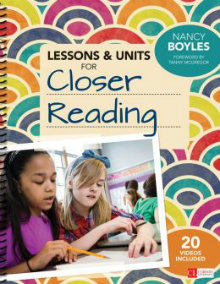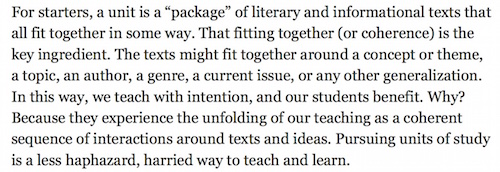Closer Reading Units For (or By) You
Lessons and Units for Closer Reading: Ready-to-Go Resources and Planning Tools Galore
By Nancy Boyles
(Corwin Literacy, 2015 – Learn more)

The importance of close reading has become even more evident since the adoption of the Common Core State Standards. In Nancy Boyles’ text, Lessons and Units for Closer Reading, she dives into the heart of curriculum design so that effective instruction can ensue.

In my quest to implement close reading immediately in grades 7 and 8, I have found few resources available that have been developed to help teachers cohesively create units and lessons that maintain the efficacy of the skill. Random lessons aside, limited units exist that provide the necessary skill set to aid in effective instruction.
Implementing literacy blocks
Modular instruction in the form of what Boyles calls pathways helps to streamline the process and make coherent application painless. She also answers important questions about implementing close reading within the literacy block.
From my experience, this is not always the easiest task to accomplish due to its in-depth and time-consuming nature. Although I see close reading as quite possibly the most relevant skill students need to acquire, it is also sometimes the most daunting and difficult task to teach.
Seeing a unit take shape
What I found to be most appealing is how Boyles creates (and shares) units around a theme, a topic, an author, a genre, a current issue, or any other generalization, then teaches us how do the same. Metacognitively, Boyles has us thinking about teaching coherently so that our intentions benefit our students.
This approach emphasizes the point that stand-alone lessons are not as effective as whole units of study, which is why she not only gives full unit examples that a teacher could implement immediately, but also guides the reader into unit creation using all of the basic components identified in the pre-created lessons. These lessons are extremely thorough and include specific guiding questions for each of the pages in each book.
Planning your own unit
A great organizer provided in the text, “Ten Planning Steps for New Units of Instruction,” fosters the creation of units by showing how to make these lessons fit with whatever texts you are using in your classroom; this is especially helpful when the materials you have access to do not necessarily match up to her pre-constructed units.
Using examples laid out in the text, it is easy to follow the guidelines Boyles identifies as important factors in the creation of modular units. This provides an outline as to how to achieve connectedness and coherence upon implementation.
You can see how easy it might be to incorporate these ideas into units you already do in Boyles’ genre unit. I currently do an Unreliable Narrator unit which involves using fractured fairy tales and the original tales, and having students identify details in each story to attempt to determine why we inherently believe one tale/version over another.
Looking at Boyles’ genre based unit, I can absolutely merge the two ideas and utilize what she has created in her text with what I have created, to deliver a tremendously effective unit of study utilizing close reading as a key skill for understanding. I imagine many teachers would be able to do this with what they are already doing.
Incorporating close reading
With 32 lessons in all, organized by eight learning pathways for approaching important themes in literature and information, this text allows you to dive right into the teaching of close reading. It is definitely a resource I will continue to utilize in my quest to incorporate close reading into all that we do in the classroom.
Download more sample pages from Boyles’ book here.
Jennifer Wirtz has been a 7th and 8th grade English Language Arts teacher at Gemini Junior High School in Niles, Illinois for over a decade. She received a B.A. and a B.S. from Loyola University Chicago and a Masters in Education from DePaul University. Currently she is also finishing up a three year stint as a Design Teacher on the Project READI research project at the University of Illinois-Chicago. She is married to a math teacher and has two young children.


































